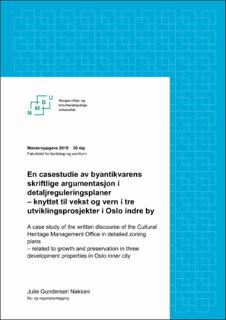| dc.contributor.advisor | Børrud, Elin | |
| dc.contributor.author | Nakken, Julie Gundersen | |
| dc.coverage.spatial | Norway, Oslo | en_US |
| dc.date.accessioned | 2020-03-16T11:11:36Z | |
| dc.date.available | 2020-03-16T11:11:36Z | |
| dc.date.issued | 2019 | |
| dc.identifier.uri | https://hdl.handle.net/11250/2646930 | |
| dc.description.abstract | Denne oppgaven undersøker hvordan byantikvarens skriftlige uttalelser til tre reguleringsplansaker i Oslo indre by uttrykker hvordan etaten argumenterer for sine sektorinteresser i møte med andre sentrale hensyn i byplanlegging.
Oslo kommunes byutviklingsstrategi om kompakt byutvikling og fortetting innenfra og ut, gir at arealer og transformasjonsområder i indre by er svært attraktive for profittsøkende utviklere. Samtidig skaper fortetting som strategi og forutsetning en interesse- og målkonflikt med kommuneplanens ambisjoner om å samtidig vektlegge og hensynta verneverdier i den historiske byen. Byantikvaren viser til målkonflikten mellom vekst og vern i sin kommentar til høringsutkast for Kommuneplan for Oslo 2015 (s.1), der byantikvaren mener den historiske byen er under utbyggingspress. I en artikkel i Aftenposten (2016) uttalte byantikvar Janne Wilberg at «kulturhistoriske verdier bør vektlegges fremfor kortsiktige utbyggingsinteresser». Wilbergs uttalelser i sin rolle som byantikvar kan oppfattes som et uttrykk for frustrasjon over at det gis rom for at andre sentrale aktører tar seg til rette på en måte som er gunstig for økonomisk verdiskapning på kort sikt, men som da kan være til skade for kulturminneinteressene.
Bærekraftig utvikling er det overordnede hensynet i all arealplanlegging. Som aktør i byutviklingen må dette også være er sentralt hensyn i byantikvarens vurderinger og rådgivning i plansaker. Oppgavens funn avdekker likevel at bærekraft ikke er et sentralt hensyn eller tema i byantikvarens verdivurdering i casene. Dette vurderes å ha sammenheng med den iboende motsetningen i sektoransvaret knyttet til vern og vekst som utfordrer byantikvarens tradisjonelle og etablerte sektorinteresse i plansaker. Ambisjonen om balansering av vekst og vern betyr at etaten både skal forvalte kulturarv og kulturminneverdier, men samtidig også sørge for at de samme bevaringsverdiene som ressurs bidrar til å skape bærekraftige løsninger i arealutvikling. | en_US |
| dc.description.abstract | This thesis examines how the written statements of the Oslo Municipality Cultural Heritage Management Office in three detailed zoning plans in Oslo inner city express how the agency argues for its sector interests in meeting other considerations in urban planning.
In Oslo, the urban development strategy on compact urban development and densification makes transformation areas in the inner city very attractive for profit-seeking developers. At the same time, densification as a strategy and premise creates a conflict of interest- and objectives with the municipal plan's ambition to simultaneously emphasize and take into account the values of the historic city. The Director of the Cultural Heritage Management Office in Oslo refers to the conflict between growth and preservation in her comment on the draft of the Municipal Masterplan for Oslo 2015 (p.1), where the Director states that the historic city is under pressure from urban development. In an article in Aftenposten (2016), the Director, Janne Wilberg stated that cultural heritage should be emphasized over short-term development interests. Wildberg’s statements can be perceived as an expression of frustration over the fact that other key players have more space to act in a way that is favourable to economic growth in the short term, but which could then be detrimental to cultural heritage interests.
Sustainable development is the overall consideration in all land use and planning. This consideration must be emphasized by the Cultural Heritage Management Office when counselling in planning matters. Nevertheless, the thesis reveals that sustainability is not a main consideration in their valuations of cultural heritage interests and the plan proposals in the three cases. This is believed to be related to the inherent contradiction in their sector responsibility of protection and growth, that challenges the Office’s traditional and established sector interest in planning procedures. The ambition of balancing growth and protection means that the Office must manage cultural heritage, while at the same time ensuring that the same cultural heritage values as resources, contribute in the process of achieving sustainable solutions. | en_US |
| dc.language.iso | nob | en_US |
| dc.publisher | Norwegian University of Life Sciences, Ås | en_US |
| dc.rights | Attribution-NonCommercial-NoDerivatives 4.0 Internasjonal | * |
| dc.rights.uri | http://creativecommons.org/licenses/by-nc-nd/4.0/deed.no | * |
| dc.subject | Byantikvaren | en_US |
| dc.subject | Bærekraftig utvikling | en_US |
| dc.subject | Kulturminner | en_US |
| dc.subject | Argumentasjonsanalyse | en_US |
| dc.title | En casestudie av byantikvarens skriftlige argumentasjon i detaljreguleringsplaner : knyttet til vekst og vern i tre utviklingsprosjekter i Oslo indre by | en_US |
| dc.title.alternative | A case study of the written discourse of the Cultural Heritage Management Office in detailed zoning plans : related to growth and preservation in three development properties in Oslo inner city | en_US |
| dc.type | Master thesis | en_US |
| dc.description.version | submittedVersion | en_US |
| dc.subject.nsi | VDP::Social science: 200 | en_US |
| dc.source.pagenumber | 44 | en_US |
| dc.description.localcode | M-BYREG | en_US |

